Team Lead Data & Intelligence
How to bet with maximum efficiency: the Go Play in Traffic method
Team Lead Data & Intelligence
According to internal reports at Adviso, 54.3% of our up-and-coming clients have no bidding rules defined, even including the “maximize clicks” bid strategy.
This is disturbing, but not entirely surprising.
Through conferences, presentations and workshops, we must continually explain the importance of understanding the auction to account managers. Usually, we would define their strategy as the “wild ass guess” bidding strategy. Maybe, the one where we don't really know, but we put a noticeably reasonable price.
A publicity auction will always include an unpredictable part: this is integral to the bidding process. However, by adding a pinch of science to the process, it is possible to bet with SWAG (“scientific wild ass guess”).

The process can be defined in four steps:
- Know your worth
- Bet accordingly
- Keep your budget in mind
- Honesty pays off
Yes, it's that easy.
At Adviso, we have created a tool called Go Play in Traffic that we use in addition to other auction engines available on the market. Its role is to ensure that bid adjustments are made to the account, following the four steps. It simulates all the possibilities in order to determine the best basic bid to test. This ensures that your campaigns will start at maximum efficiency, before the start of optimization learning.
1- KNOW YOUR WORTH
The guessing game is mainly played in the Keyword Planner by asking Google what the best bid is based on your daily budget. Unfortunately, this is an imperfect technique.
To start, you must go to the Keyword Planner and insert all the possible keywords in order to simulate the results.
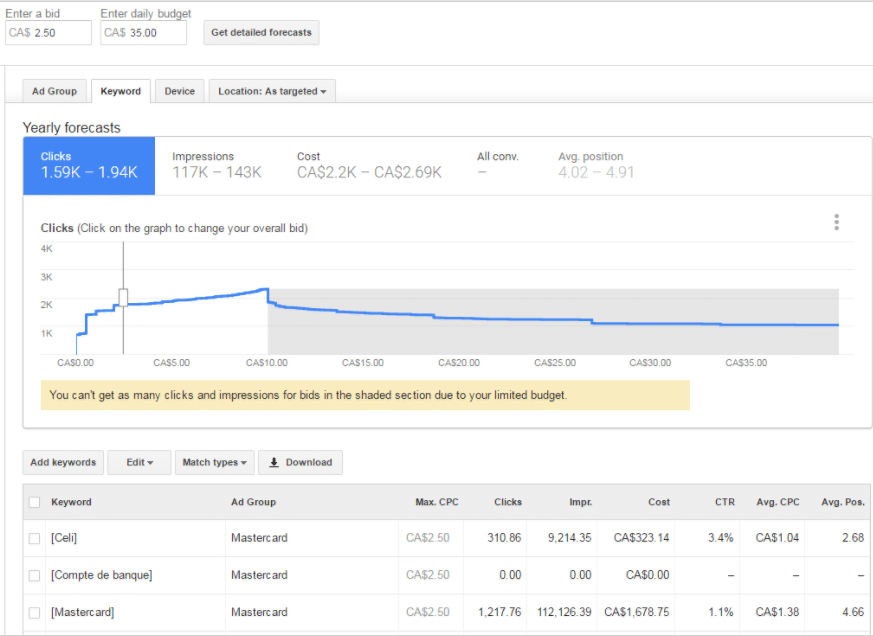
You'll soon find that Google tells you the maximum amount of clicks per day you could get for a higher bid before declining because of your daily budget limit. This represents the gray part of the image above.
The logical assumption would be to target this maximum click yield relative to the daily spend limit.
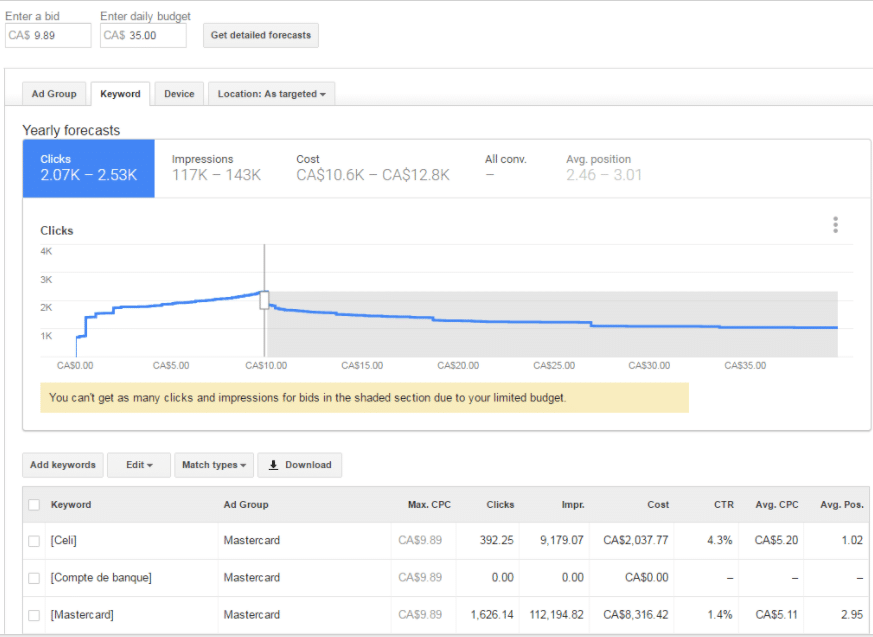
Unfortunately, this assumption leads to a nasty surprise. When you compare the previous two performance simulations, you find that by maximizing clicks per day based on your budget constraints, you increased your clicks by 25%, which resulted in a 600% increase in your costs.
Ouch. It hurts.

This technique offered by Google does not take into consideration the real value of the potential visit. Note that it is impossible to add this variable in the interface. It assigns the same value to all keywords and does not add a potential Revenue per Visit constraint. Also, we have noticed that following this technique favors Google's revenue stream, not your profitability.
The question remains: how to calculate your Revenue per Visit?
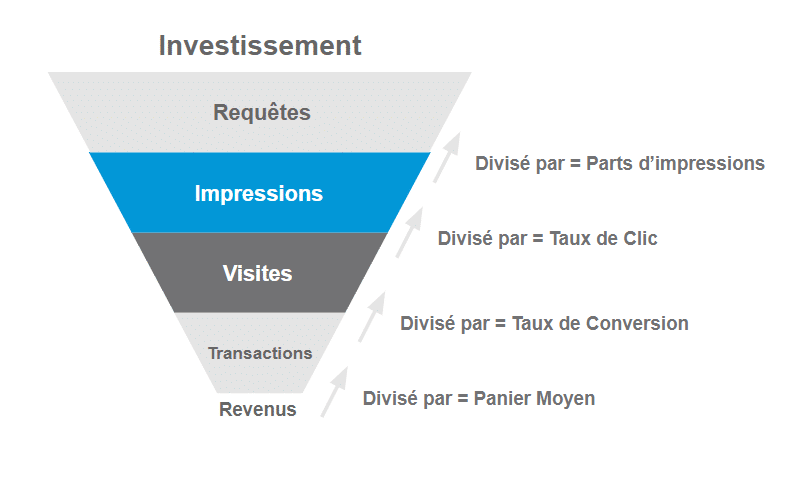
First, you should create your own version of the visual above to visualize the size of the market (queries), define the share you're looking to achieve (volume of impressions), and then estimate the click-through rate (the Keyword Planner will be very useful to you here!). You can then go to your analytical platform and find your conversion rate for this product, observe the value of the average basket and finally define your potential income. You now have a better idea of what you are trying to accomplish.
You can divide the conversion rate into three overall segments: “Top funnel” (finding information), “Mid funnel” (comparison) and “Low funnel” (purchasing behavior).
You can now use one of these two formulas to calculate Revenue per Visit:

WHERE
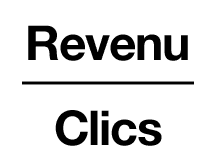
In the end, the two formulas are equal. Choice is a matter of preference and access to information.
If you are in a situation where you need to explain these equations to someone, I suggest you use the following example:
If there is a 1 in 100 chance that your $500 game will be bought, what is the maximum amount you would be willing to pay for each unique person reached?

$5 is the maximum amount you should pay for each opportunity to get zero return on investment.
2 – BET ACCORDINGLY
Now that your value is set, it's time to determine how much you should bet.
Let's go back to the auction formula. Yes, I ALWAYS refer you to Google's formula. Learn it. Tame it. Love her without restraint!
If you need to refresh your memory on this, please refer to this video .
If the price you pay is equal to the score of the competition divided by your quality, what is the objective of your bid? Its objective is to properly prioritize your interest in each specific keyword.
For this reason , if you bet higher than what you should statistically win in income, you will lose in the long run. Use your common sense. By not betting your real value, you harm your performance
Here are the reasons why:
- If you bet too high and reach a higher position in the auction, you will end up paying more than you were originally willing to pay.
- If you bid too high or too low and reach the same position as with a higher or lower bid, you end up paying the SAME PRICE.
- If you bid lower to save on your budget, and end up lower on the bidding ladder, this results in a loss of potential customers.
To reiterate, your optimization time should be used to increase your Quality Score, and your bidding strategy should focus on the true value of all clicks.
Bid optimization is the act of increasing the accuracy of each potential user's click value. But ultimately, each bid should equal the dynamic value of a potential visitor. To help you with this, Google offers several auction solutions; use them to your advantage. A great start is Smart Bidding .
3 – KEEP YOUR BUDGET IN MIND
Imagine this scenario: you have an extremely successful product with a limited advertising budget, and you have on top of that 20 other underperforming products that also each have a budget allocation. What is the problem?
You decrease your overall transactional performance. The selling product should have a full budget long before it allocates to the other 20. It's simple, right?
In the visual below, the blue part represents a customer who used a linear bid strategy with a daily budget set at the campaign level to ensure equal coverage across all products. The gray part represents the optimized visits, with a level of confidence, if the budget was always maximized on the best performing keywords. As you can see, if you had enough budgets to cover everything 100%, you would get the same result as with an optimization. But let's be real, you never have enough budgets to do that.
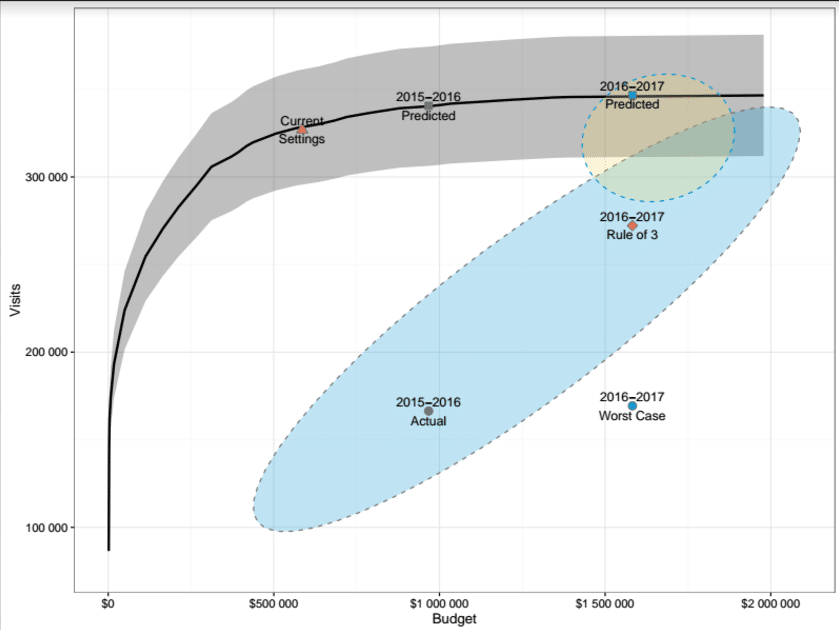
4 – HONESTY PAYS OFF
Following these steps to create a battle plan is easy. However, like any battle plan, it will not survive contact with the enemy. Be flexible.
Keep the actual value of a click, consider time of day, past visits, budget constraints, promotion, etc. is complex and requires a lot of adjustments. Every business should use a bid optimization tool. If you don't know where to start, Google gives you tools for free.
Here are three conclusions that emerged from this study about behavior and honesty:
- Being honest increases your performance
- Being honest increases social well-being
- Being honest reduces supplier profit
Social welfare defines how advertisers fare in the auction. Simply stated, if you overestimate the value of your visitor, you create inflation for other advertisers. This inflation therefore becomes very profitable for the supplier.
Ultimately, Go Play In Traffic's mission is to ensure marketers put their money where it's valuable by being as accurate as possible. Of course, there will always be an unknown element at auction, but by adding a solid methodology to the process, we are able to make an informed estimate rather than a guess.








